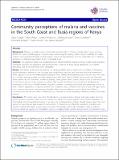| dc.contributor.author | Ojakaa, David I | |
| dc.contributor.author | Ofware, Peter | |
| dc.contributor.author | Machira, Yvonne W | |
| dc.contributor.author | Yamo, Emmanuel | |
| dc.contributor.author | Collymore, Yvette | |
| dc.contributor.author | Ba-Nguz, Antoinette | |
| dc.contributor.author | Vansadia, Preeti | |
| dc.contributor.author | Bingham, Allison | |
| dc.date.accessioned | 2021-08-31T10:34:25Z | |
| dc.date.available | 2021-08-31T10:34:25Z | |
| dc.date.issued | 5/30/2011 | |
| dc.identifier.citation | Ojakaa, D.I., Ofware, P., Machira, Y.W. et al. Community perceptions of malaria and vaccines in the South Coast and Busia regions of Kenya. Malar J 10, 147 (2011). https://doi.org/10.1186/1475-2875-10-147 Download citation | en_US |
| dc.identifier.issn | 1475-2875 | |
| dc.identifier.other | https://doi.org/10.1186/1475-2875-10-147 | |
| dc.identifier.uri | http://repository.amref.org/handle/123456789/185 | |
| dc.description | © 2011 Ojakaa et al; licensee BioMed Central Ltd. This is an Open Access article distributed under the terms of the Creative Commons
Attribution License (http://creativecommons.org/licenses/by/2.0), which permits unrestricted use, distribution, and reproduction in
any medium, provided the original work is properly cited. | en_US |
| dc.description.abstract | Background
Malaria is a leading cause of morbidity and mortality in children younger than 5 years in Kenya. Within the context of planning for a vaccine to be used alongside existing malaria control methods, this study explores sociocultural and health communications issues among individuals who are responsible for or influence decisions on childhood vaccination at the community level.
Methods
This qualitative study was conducted in two malaria-endemic regions of Kenya--South Coast and Busia. Participant selection was purposive and criterion based. A total of 20 focus group discussions, 22 in-depth interviews, and 18 exit interviews were conducted.
Results
Participants understand that malaria is a serious problem that no single tool can defeat. Communities would welcome a malaria vaccine, although they would have questions and concerns about the intervention. While support for local child immunization programs exists, limited understanding about vaccines and what they do is evident among younger and older people, particularly men. Even as health care providers are frustrated when parents do not have their children vaccinated, some parents have concerns about access to and the quality of vaccination services. Some women, including older mothers and those less economically privileged, see themselves as the focus of health workers' negative comments associated with either their parenting choices or their children's appearance. In general, parents and caregivers weigh several factors--such as personal opportunity costs, resource constraints, and perceived benefits--when deciding whether or not to have their children vaccinated, and the decision often is influenced by a network of people, including community leaders and health workers.
Conclusions
The study raises issues that should inform a communications strategy and guide policy decisions within Kenya on eventual malaria vaccine introduction. Unlike the current practice, where health education on child welfare and immunization focuses on women, the communications strategy should equally target men and women in ways that are appropriate for each gender. It should involve influential community members and provide needed information and reassurances about immunization. Efforts also should be made to address concerns about the quality of immunization services--including health workers' interpersonal communication skills. | en_US |
| dc.language.iso | en | en_US |
| dc.publisher | BioMed Central | en_US |
| dc.subject | Malaria | en_US |
| dc.subject | Community Health Worker | en_US |
| dc.subject | Communication Strategy | en_US |
| dc.subject | Immunization Program | en_US |
| dc.subject | Malaria Vaccine | en_US |
| dc.title | Community Perceptions of Malaria and Vaccines in the South Coast and Busia Regions of Kenya | en_US |
| dc.type | Article, Journal | en_US |

